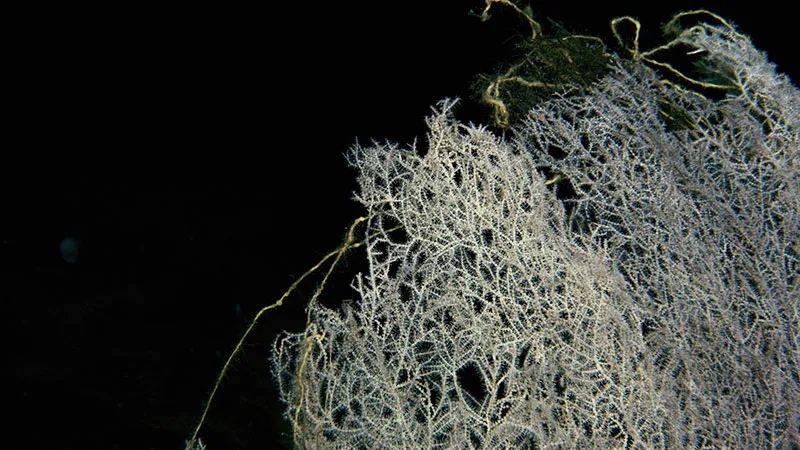When people think about corals, most picture the multi-hued reef-builders that reside in balmy waters off tropical beaches. But not all corals stick to the shallows. For example, most members of the order Antipatharia do not live within 160 feet of the surface. Some even reside at depths deeper than 26,000 feet. Commonly known as black corals due to their ink-colored skeletons, these corals are staples of deep-sea ecosystems around the world.
However, black corals remain enigmatic due to the challenges of studying them in the deep sea. This makes it difficult for scientists to assess how black corals, whose skeletons (which are made out of chitin, the same material that composes an insect’s exoskeleton) are prized components of jewelry, are responding to threats like poaching, ocean acidification and climate change.
“Describing these species is fundamental information to make conservation decisions,” said Jeremy Horowitz, a postdoctoral researcher at the National Museum of Natural History who specializes in studying black corals. “You have to know it before you can protect it.”

In a paper published this week in the journal ZooKeys, Horowitz and his colleagues at the museum and the University of Puerto Rico described Aphanipathes puertoricoensis, a new species of black coral that sports branching features found in multiple coral groups that diverged roughly 100 million years ago.

The new black coral species was discovered in April 2022 during a joint Smithsonian and National Oceanic and Atmospheric (NOAA) expedition to a stretch of the Caribbean Sea just south of Puerto Rico. Here, the seafloor bottoms out into a network of deep-sea canyons and seamounts that remain largely unexplored.
The expedition, led by research zoologist Andrea Quattrini, the museum’s curator of corals and one of Horowitz’s co-authors on the new paper, aimed to explore some of this abyssal terrain and catalog some of the creatures that reside there. Many of these animals live far deeper than human divers can go. So the researchers deployed a remotely operated unmanned vehicle (ROV) called the Global Explorer to depths as deep as 4,000 feet below the ocean’s surface.

Over seven dives, the ROV mapped 180 square nautical miles of the deep-sea floor. It collected a suite of biological samples and hours of footage for the researchers to parse on the research vessel above. They observed ghostly, blob-like predators called tunicates, gangly bristle stars, vibrant comb jellies and tiny crustaceans with fused eyes that live inside glass sponges. They even collected a colony of small invertebrates called bryozoa that had not been collected since a Smithsonian expedition to the Puerto Rico Trench in 1933.

They also found a multitude of species new to science. While exploring a canyon nearly 1,200 feet below the surface, the ROV came across a scraggly patch of black coral reminiscent of a deep-sea tumbleweed. As the ROV snipped off one of the coral’s spindly branches, Quattrini sent Horowitz, who was back in Washington, a picture of the coral on the ROV’s live feed. “She shared a picture of this coral and I immediately had no idea what it was,” Horowitz said.
When the expedition’s trove of specimens arrived in Washington, Horowitz could finally take a closer look at the puzzling coral. With long, coiled branches emanating from a short stalk like a tiny tree, the coral sported features found in multiple genera, or groups, of black coral that diverged long ago.

To assign the new species in the right group, Horowitz placed a fragment of the coral specimen underneath a high-powered scanning electron microscope at the museum. That gave him a microscopic view of the miniscule spines that line the coral skeleton. Like a fingerprint, a coral species’ spines have their own distinct shape. Comparing these spines to known black coral species allowed Horowitz to get a better idea of where this new species may slot into the black coral family tree. To be sure, the researchers also used cutting edge techniques to compare the new species’ genetic code with other corals.
All this work allowed the researchers to find a taxonomic home for the new species in the genus Aphanipathes. They christened the black coral with the species name puertoricoensis in homage to the island near where it was found.

Horowitz believes its resemblance to other groups of black coral reveals how helpful a simple body type is for survival in the deep-sea. “This simple morphological structure is evolving over and over again, probably because the conditions are the same in these different areas,” he said. “This simple structure is what works.”
The team is still examining the specimens collected and expects to name additional new species in the near future. There are also plans to go back and conduct further field research in the deep-sea canyons and ridges off Puerto Rico. “Every time we go back to this region, we find new species,” Horowitz said.
But there is also plenty to uncover closer to home. The piece of black coral from Puerto Rico recently joined the museum’s 4,000 other black coral specimens — the largest such collection in the world. Many of these black coral specimens likely represent undescribed species hiding in plain sight. According to Horowitz, “we don’t even have to go offshore to find new species.”
Reference:
Horowitz J, Opresko DM, González-García MP, Quattrini AM (2023) Description of a new species of black coral in the family Aphanipathidae (Anthozoa, Antipatharia) from Puerto Rico. ZooKeys 1173: 97-110. https://doi.org/10.3897/zookeys.1173.104141
Story originally published by the Smithsonian Magazine. Republished with permission.










